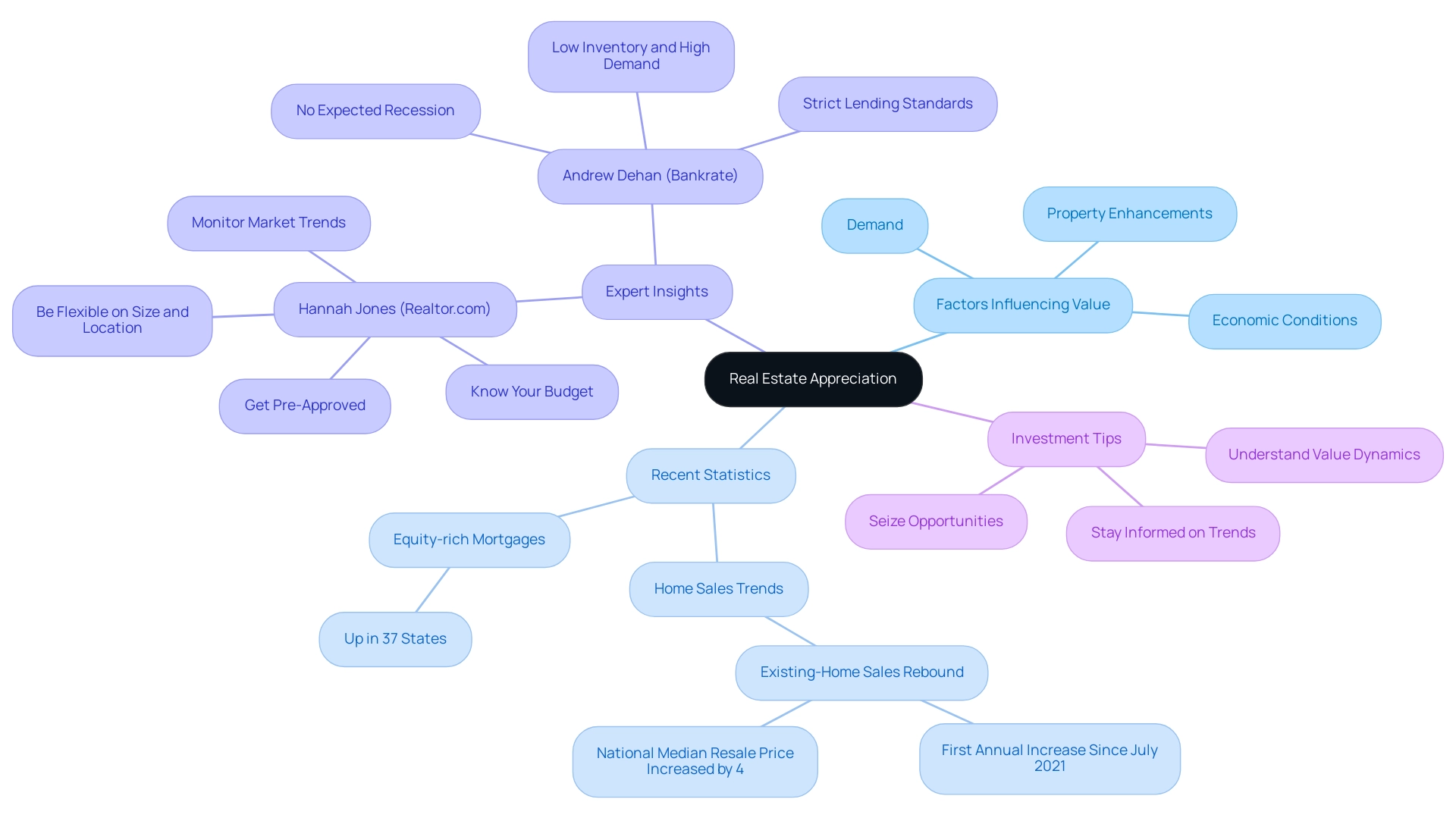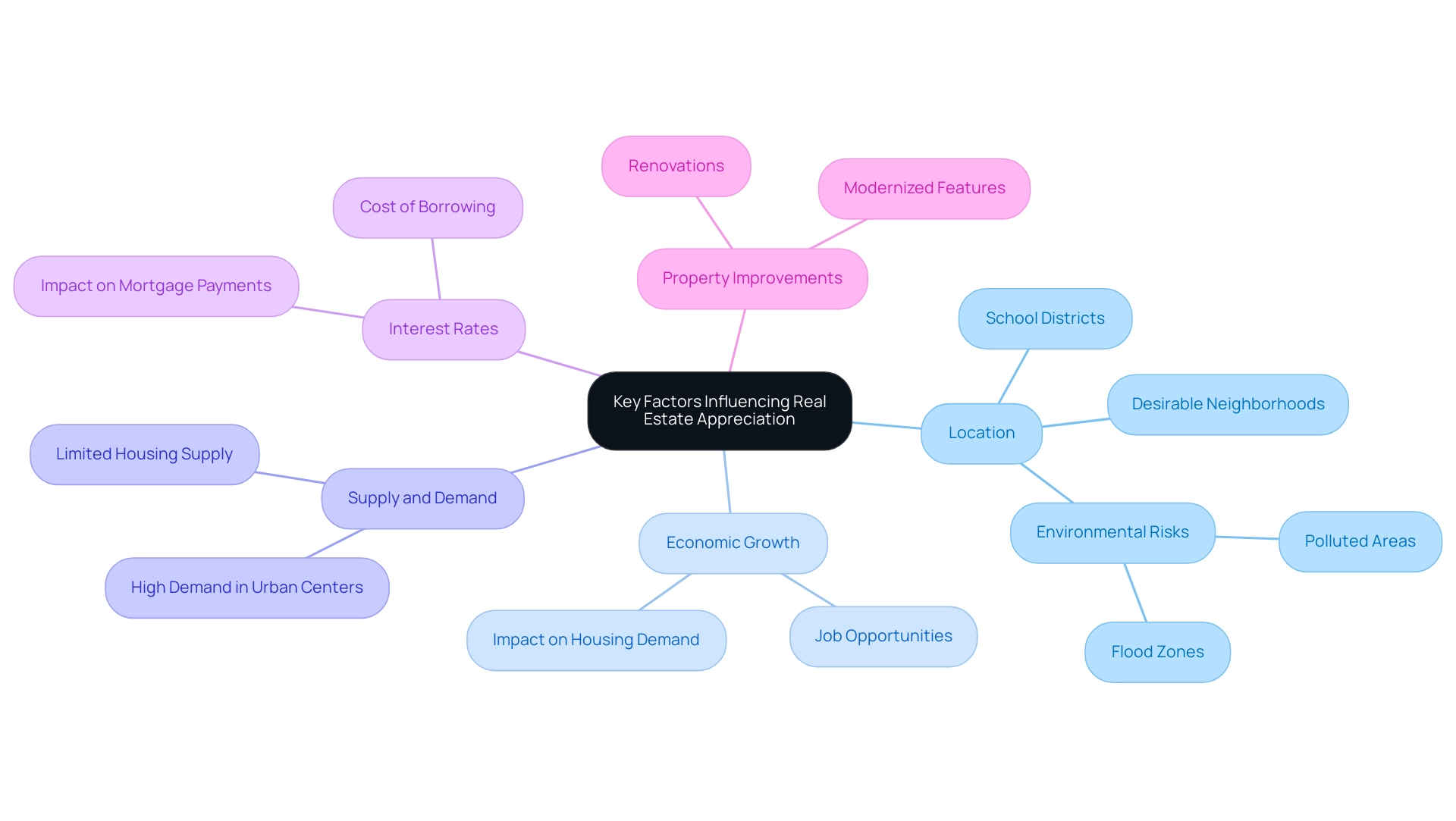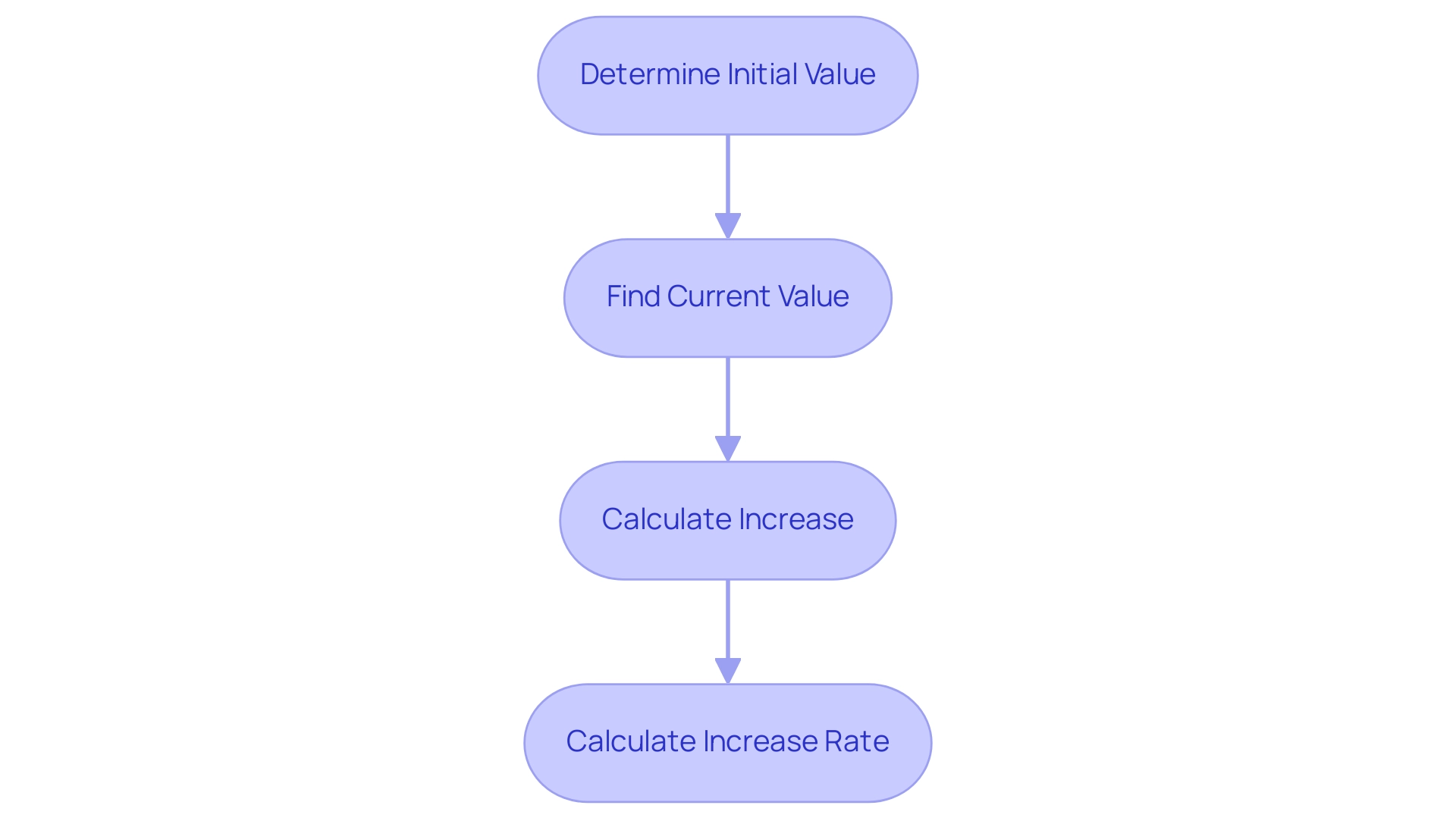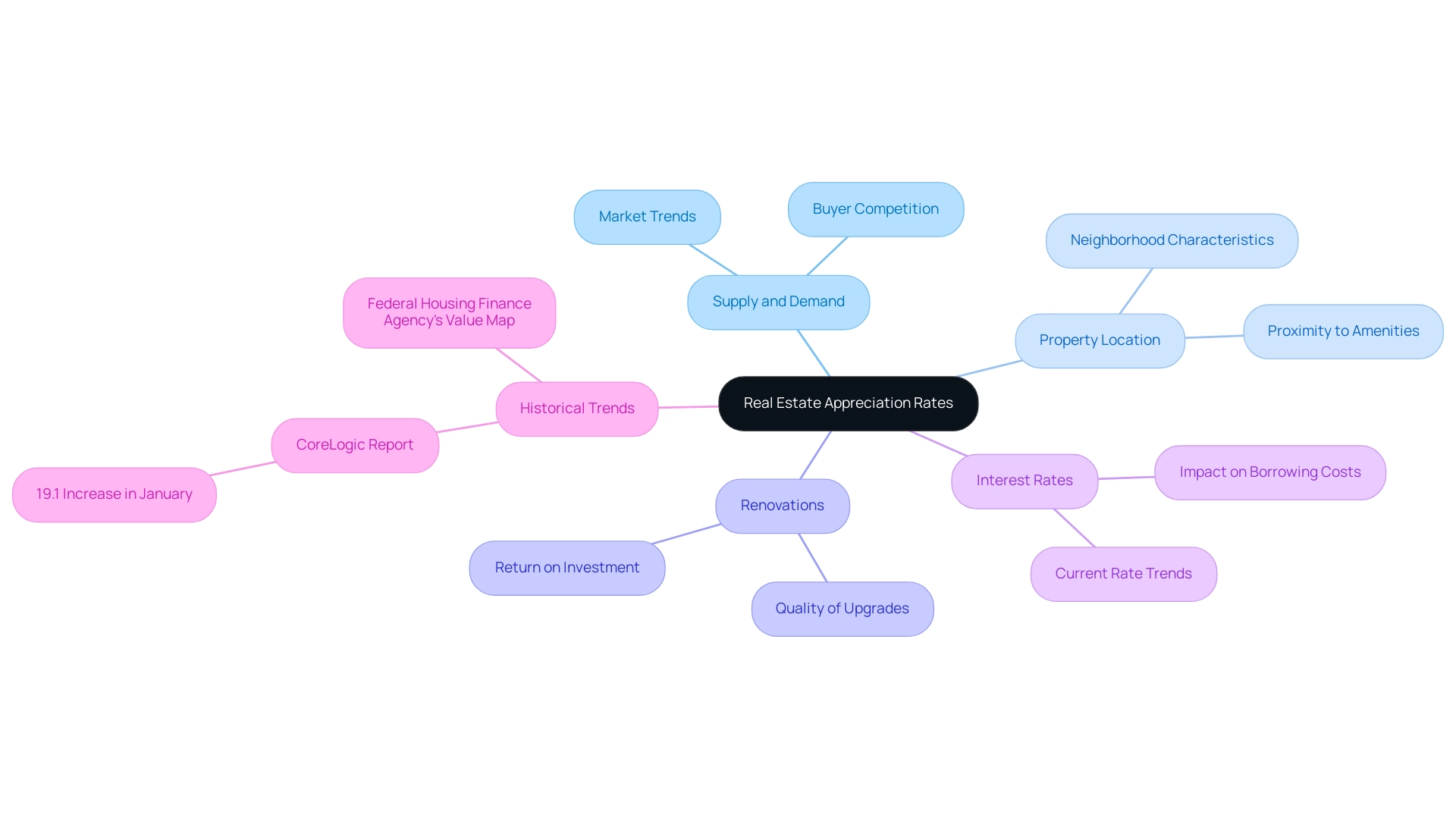Overview
Real estate appreciation rates serve as a critical metric for investors, reflecting the increase in property value over time. These rates are influenced by various factors, including location, economic conditions, and property improvements. Understanding these rates is crucial; it empowers investors to make informed decisions, capitalize on prevailing market trends, and enhance their potential returns on investment. By leveraging strategic actions and insights into local market dynamics, investors can position themselves advantageously in the real estate landscape.
Introduction
In the dynamic world of real estate, understanding appreciation is crucial for investors aiming to maximize their returns. Real estate appreciation—the increase in property value over time—is influenced by a myriad of factors, including market demand, economic conditions, and property improvements. As the market continues to evolve, with certain regions experiencing significant growth, staying informed about appreciation trends becomes essential for making strategic investment decisions.
This article delves into the intricacies of real estate appreciation, exploring its types, key influencing factors, and effective strategies for enhancing property value. By providing insights into the current landscape, we empower investors to navigate this ever-changing market successfully.
What is Real Estate Appreciation?
Real estate value growth represents the increase in an asset's worth over time, a pivotal concept for investors aiming to maximize their returns. This valuation can be influenced by various factors, including demand, economic conditions, and enhancements made to the property itself. For instance, a home acquired for $300,000 could appreciate to $350,000 over a five-year span, resulting in a $50,000 increase in value.
As we look toward 2025, the real estate appreciation rate reveals a vigorous environment, with numerous regions witnessing substantial growth. The National Association of Realtors (NAR) has pinpointed several areas likely to outperform based on critical trends and metrics, underscoring the necessity of staying informed about local conditions. Recent statistics show that the percentage of equity-rich mortgages has risen annually in 37 states during the third quarter of 2025, reflecting a bolstered environment where homeowners are accumulating significant equity in their properties.
A compelling case study is the resurgence in existing-home sales noted in October 2024, coinciding with an uptick in mortgage rates. This marked the first annual sales increase since July 2021, with the national median resale home price climbing by 4%. Such trends illustrate the resilience of the housing market and the potential for continued growth.
Understanding real estate value increase is essential for investors, as it directly impacts their potential returns on investment (ROI). Experts highlight the significance of being aware of real estate appreciation rate trends to make informed purchasing choices. As Hannah Jones from Realtor.com advises, prospective buyers should grasp their budget, remain flexible regarding home size and location, monitor trends, and secure pre-approval from a reliable lender to strengthen their buying position.
Moreover, Andrew Dehan, a senior writer at Bankrate, notes, "Lending standards are considerably more strict now than they were prior to the Great Recession, and with low inventory and high demand both persisting, the housing sector is not expected to enter a recession in the coming year." This insight reinforces the notion that a robust understanding of value dynamics can empower investors to navigate the complexities of the financial landscape effectively.
In summary, the real estate appreciation rate not only signifies the increase in asset worth over time but also serves as a crucial indicator of market health. Investors who grasp the factors influencing value growth and observe current trends are better positioned to seize opportunities in the ever-evolving real property market.

Key Factors Influencing Real Estate Appreciation
Several key factors significantly influence real estate appreciation, each playing a crucial role in determining property values:
- Location: Properties situated in desirable neighborhoods tend to appreciate at a faster rate due to heightened demand. For instance, a study of over 20,000 houses in the Greater Boston Area revealed that homes in well-rated school districts or near amenities consistently outperformed others in terms of appreciation. Additionally, environmental risks, such as flood zones and polluted areas, can significantly deter potential buyers, affecting real estate values. Properties located in safe and desirable environments tend to maintain or increase their value, while those in hazardous areas may experience a decline.
- Economic Growth: A robust economy typically correlates with increased job opportunities, which in turn drives demand for housing. As employment rates rise, more individuals seek homes, leading to upward pressure on property prices. This relationship highlights the importance of monitoring economic indicators to anticipate trends in the real estate appreciation rate. A review of literature on homeownership reveals its impact on various household behaviors and outcomes, highlighting the broader implications of economic growth on the real estate appreciation rate.
- Supply and Demand: In areas where housing supply is limited but demand remains high, significant price increases are often observed. This dynamic is particularly evident in urban centers where land is scarce, and new construction cannot keep pace with population growth.
- Interest Rates: The cost of borrowing plays a pivotal role in real estate sectors. Lower interest rates reduce monthly mortgage payments, making homeownership more accessible and stimulating buyer activity. This surge in demand can lead to increased real estate values, particularly in competitive markets.
- Property Improvements: Renovations and upgrades can substantially enhance a property's value. Homes that are well-maintained or have modernized features often see greater appreciation compared to those that are not updated. Investors should consider the return on investment for various improvements when planning renovations.
Understanding these factors is essential for making informed investment decisions. Ongoing tracking of correlation statistics is crucial for adjusting to shifting economic conditions. Investors can utilize tools such as market analysis reports and property software to track trends and make data-driven decisions.
Expert opinions further highlight the effect of location on property value increase. Real property experts often observe that the appeal of a neighborhood can significantly influence long-term value. As Christina Foster, a seasoned investor, remarked, "He was patient with all my questions and concerns, even when I would ask the same thing multiple times," illustrating the importance of thorough understanding and communication in navigating these complexities.
In summary, the interplay between economic growth, location, and market dynamics influences the real estate appreciation rate and property value trends. Investors who stay informed about these factors are better positioned to capitalize on opportunities in the ever-evolving property landscape.

Types of Real Estate Appreciation: Natural vs. Forced
The increase in real estate value can be categorized into two primary types: natural increase and forced increase, both of which significantly influence the real estate appreciation rate.
Natural Appreciation: This type of appreciation occurs organically, driven by economic forces such as growth, increased demand, and demographic shifts. It tends to be gradual, influenced by external factors like location desirability and overall economic conditions. For instance, in 2025, many regions are experiencing a notable rise in real estate values, with average sale prices reaching approximately £75,726. This statistic reflects the positive impact of these economic dynamics, underscoring the importance of understanding local trends.
Forced Appreciation: In contrast, forced appreciation is achieved through intentional actions taken by the owner. This can include renovations, upgrades, or improvements that enhance the asset's value, irrespective of broader market conditions. For example, adding a new bathroom or modernizing the kitchen can significantly elevate a property's worth. As noted by Vivian, a freelance realty writer, "It's worth remembering that forced increase doesn’t always need to be immediate." Investors often leverage this strategy to maximize returns, particularly in up-and-coming areas where potential for improvement is evident. By combining both natural and forced value enhancement strategies, substantial benefits can be realized.
Grasping the distinction between these two forms of value recognition is essential for real estate investors. While natural recognition depends on external economic influences, forced enhancement enables investors to manage their investment's worth through proactive actions. This distinction is vital for developing effective investment strategies.
In practice, instances of natural growth can be observed in neighborhoods undergoing revitalization, where increased demand leads to a higher real estate appreciation rate and rising values. Conversely, case studies of forced appreciation often highlight successful renovations that have transformed real estate, contributing to a significant increase in the appreciation rate. Properties that have undergone strategic improvements frequently see a marked increase in their appraisal values, demonstrating the effectiveness of this approach.
Furthermore, effective realty investment tactics also hinge on timely upkeep, tenant selection, and awareness of neighborhood trends. These factors play a critical role in ensuring that properties not only appreciate in value but also remain attractive to potential buyers or renters.
As the property market evolves in 2025, staying informed about these value-increasing strategies will empower investors to make data-driven choices. The Zero Flux Newsletter serves as a vital resource, providing curated insights and trends that help investors capitalize on both natural market trends and the potential for forced value increases.
How to Calculate Real Estate Appreciation
Calculating the real estate appreciation rate requires a systematic approach that offers valuable insights for investors. Here’s a step-by-step guide to navigate this process effectively:
- Determine the Initial Value: Begin by identifying the purchase price of the asset. This figure serves as the baseline for your calculations.
- Find the Current Value: Assess the present worth of the property. This can be achieved through comparative market analysis or by consulting real estate professionals.
- Calculate the Increase: Subtract the initial value from the current value to determine the total increase. For example, if a property was purchased for $250,000 and is now valued at $300,000, the increase totals $50,000.
- Calculate the Increase Rate: To express this increase as a percentage, divide the increase amount by the initial value and multiply by 100. In this case, the calculation would be ($50,000 / $250,000) * 100, resulting in a 20% increase rate.
Understanding these calculations is crucial, especially in a fluctuating market. Recent data indicates that the Austin, Texas area has seen a decline of 3.2% in home prices. This decline underscores the importance of staying informed about local economic trends, as such fluctuations can significantly impact value assessments.
Moreover, several factors influence the real estate appreciation rate, including market supply and demand, property location, renovations, and interest rates. A comprehensive study on this topic highlights the complexity of predicting value trends due to these multiple influencing factors. As Richard Haddad, Executive Editor at HomeLight, aptly states, "At HomeLight, our vision is a world where every real estate transaction is simple, certain, and satisfying."
Resources like the Federal Housing Finance Agency's four-quarter appreciation map can be invaluable for potential homebuyers and investors, offering state-by-state estimates of appreciation rates.
For investors, smaller homes often yield higher returns compared to larger properties, assuming comparable land sizes. This insight can guide investment choices, particularly in areas where space is at a premium.
By following these steps and utilizing available resources, investors can make informed decisions regarding their property investments, ultimately enhancing their portfolio's performance.

Historical Trends in Real Estate Appreciation
The rates of real estate appreciation have historically fluctuated in response to economic conditions and cycles. For instance, during the housing surge from 2000 to 2006, numerous areas experienced yearly growth rates exceeding 10%. However, a significant decline occurred in 2008, resulting in adverse value changes across many regions.
In the years following this downturn, the real estate appreciation rate has stabilized, with many areas now witnessing average annual increases between 3% and 5%.
Looking ahead to 2025, the trend of median sale prices is anticipated to continue reflecting the dynamics of supply and demand. The median home sales price, which surged from $337,500 in the third quarter of 2020 to a remarkable 25% increase, underscores the ongoing changes in the industry. Currently, this landscape is characterized by a mortgage rate stalemate, where potential homebuyers are often priced out, and existing homeowners hesitate to sell due to favorable low mortgage rates.
As one expert observed, "The housing sector is in a mortgage rate stalemate: Homebuyers are priced out, and homeowners are reluctant to sell and trade in their low mortgage rates."
Understanding these historical trends and the impact of economic cycles on the real estate appreciation rate is crucial for investors. By examining past performance alongside present conditions, investors can more accurately assess potential risks and rewards, enabling informed choices in a complex and ever-evolving property environment. This data-driven approach, exemplified by Zero Flux's commitment to data integrity and its unique sourcing from a diverse array of credible outlets, is essential for navigating the intricacies of real property investment.
The Role of Economic Conditions in Property Appreciation
Economic conditions play a pivotal role in determining property appreciation rates, influenced by several key indicators that shape market dynamics.
- GDP Growth: A robust economy typically correlates with heightened demand for housing, driving property prices upward. Economists observe that sustained GDP growth can lead to a more competitive housing sector, as buyers are increasingly willing to invest in real estate.
- Employment Rates: Increased employment rates bolster consumer confidence and purchasing power, resulting in a surge in home sales. When individuals feel secure in their jobs, they are more likely to make significant financial commitments, such as purchasing a home.
- Inflation: Moderate inflation often contributes to rising property values, as the costs of materials and labor increase. However, excessive inflation can erode purchasing power, potentially leading to decreased demand for housing. Investors should closely monitor inflation trends, as they can significantly impact economic conditions.
- Interest Rates: The relationship between interest rates and real estate demand is critical. Lower interest rates generally stimulate demand by making mortgages more affordable, while higher rates can deter potential buyers, slowing market activity.
- Ongoing Costs: Investors must consider that approximately 1.5% of a home’s value is typically allocated for annual repair and maintenance expenses. This statistic is essential for understanding the long-term financial commitments associated with real estate ownership.
Recent case studies illustrate these dynamics effectively. For instance, post-pandemic migration trends reveal that as remote work became more prevalent, many buyers sought homes in suburban areas, driving up real estate values in those regions. This shift underscores how economic factors—such as job flexibility and lifestyle modifications—can influence real property demand and value.
Furthermore, expert opinions highlight the importance of monitoring economic indicators. As Jon Wade, a realty specialist, emphasizes, "Smart home technology is becoming essential for many purchasers," suggesting that changing buyer preferences, shaped by economic factors, also contribute to market value. Additionally, design trends for 2025 indicate that soft or warm whites are preferred for main living areas, while off-white siding is expected to be trendy for exteriors.
These aesthetic preferences can significantly influence property values and buyer decisions.
In 2025, the interaction among GDP growth, employment rates, and housing trends will continue to influence the real estate appreciation rate. Investors should remain vigilant in analyzing these economic indicators to make informed decisions in a rapidly changing market.
Strategies to Enhance Property Value and Appreciation
To effectively enhance property value and appreciation, investors should consider several key strategies:
- Renovations: Prioritize kitchen and bathroom upgrades, as these renovations consistently yield the highest returns on investment. For instance, a midrange kitchen remodel averages a cost of $27,492 and leads to an average resale value of $26,406, allowing for a cost recouped of approximately 96.1%. This makes it a smart choice for value enhancement.
- Curb Appeal: Enhancing the exterior of the building is crucial. Simple improvements like landscaping, fresh paint, and regular upkeep can significantly attract potential buyers and increase overall asset value. Statistics indicate that homes with strong curb appeal can sell for 7-14% more than similar homes without these enhancements.
- Energy Efficiency: Investing in energy-efficient upgrades, such as solar panels or enhanced insulation, not only reduces utility costs but also appeals to a growing demographic of environmentally conscious buyers. These upgrades can lead to higher resale values, with some homeowners recouping over 100% of their investment.
- Timing of the Economy: Understanding market dynamics is essential. Purchasing properties during a buyer's market, when prices are lower, and selling during a seller's market can maximize appreciation. Historical data shows that strategic timing can lead to significant financial gains.
- Expert Insights: Real property professionals emphasize the importance of vision in renovations. As Russell, a seasoned realty expert, noted, "Some buyers just don’t have the vision to see what it could be," highlighting the need for thoughtful improvements that resonate with potential buyers.
- Successful Case Studies: The home remodeling industry has seen substantial growth, with businesses leveraging data from research reports to stay informed about trends. For example, installing a new garage door, which costs an average of $4,513, can recoup an impressive 193.9% in resale value, showcasing the potential of targeted renovations.
By applying these tactics, investors can significantly improve asset worth and guarantee a positive return on investment, positively affecting the real estate appreciation rate in the constantly changing realty sector.
Why Understanding Appreciation Rates is Crucial for Investors
Understanding the real estate appreciation rate is crucial for investors, as it significantly impacts their investment strategies and potential returns. A comprehensive grasp of the factors influencing this rate—such as supply and demand, property location, renovations, and interest rates—enables investors to make informed decisions that align with their financial goals. For example, CoreLogic recently reported a remarkable increase in home prices of 19.1% in January, marking the highest level in at least 45 years.
Furthermore, the National Association of Realtors (NAR) has developed metropolitan statistical area (MSA) profiles detailing demographics and characteristics of home buyers in the U.S., with median home values calculated for 3,110 counties and county-equivalents. This statistic underscores the importance of remaining attuned to economic dynamics.
Investors can refine their strategies by analyzing historical trends and accurately calculating the real estate appreciation rate. Resources like the Federal Housing Finance Agency's value map offer valuable insights into regional performance, enabling investors to identify promising markets. Additionally, case studies illustrate that understanding these factors is vital for making sound property purchases and estimating future value.
The case study titled "What Affects Real Estate Appreciation?" delves into various influences on valuation and provides a formula for calculating it, which can be instrumental for investors.
Financial advisors emphasize that a well-informed approach to understanding the real estate appreciation rate can profoundly impact investment strategies. As Nadia Evangelou, Senior Economist and Director of Real Estate Research, remarked at the 2025 Real Estate Forecast Summit, recognizing the nuances of value increase allows investors to tailor their portfolios to maximize returns, whether focused on long-term wealth accumulation or short-term gains. Ultimately, a solid understanding of the real estate appreciation rate is not merely beneficial; it is essential for achieving success in the competitive property market.
Zero Flux's commitment to quality content enhances subscriber engagement and establishes it as a leading authority in real estate information, making it an indispensable resource for investors.

Conclusion
Real estate appreciation stands as a pivotal concept, profoundly influencing the investment landscape. By grasping its definition and recognizing the two primary types—natural and forced appreciation—alongside the key factors that affect property values, including location, economic conditions, and market dynamics, investors are better equipped to make strategic decisions. Current trends reveal a robust market, with numerous regions experiencing significant appreciation rates. This underscores the necessity of remaining informed about local conditions and economic indicators.
Investors can enhance property values through effective strategies such as:
- Renovations
- Improving curb appeal
- Implementing energy-efficient upgrades
These initiatives not only elevate a property's worth but also resonate with evolving buyer preferences. Moreover, a comprehensive understanding of appreciation rates, bolstered by historical trends and precise calculations, empowers investors to pinpoint promising markets and tailor their strategies accordingly.
Ultimately, adopting a well-informed approach to real estate appreciation is essential for maximizing returns in a dynamic market. By consistently monitoring key indicators and grasping the intricacies of appreciation, investors can adeptly navigate the complexities of real estate investment and capitalize on growth opportunities. The insights provided serve as a roadmap for achieving success and making informed decisions in the competitive real estate landscape.




